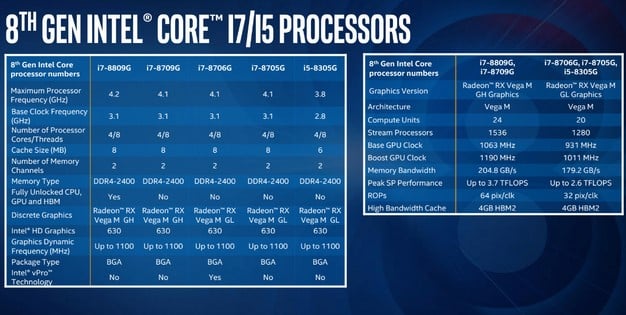Intel Family Of 8th Gen Core Processors With AMD Radeon RX Vega M Graphics Unveiled
Well, here we are at CES 2018, and Intel is giving us more details on its 8th generation Intel Core processors with integrated Radeon RX Vega M graphics. The mashup of an Intel processor with an AMD GPU is made possible by the Embedded Multi-Die Interconnect Bridge (EMIB), which provides a high-speed data interconnect between the processor, GPU and 4GB of second-generation High-Bandwidth Memory (HBM2).
In this case, Intel is delivering 8th generation H-Series Core processors that will be available in 65W TDP (laptops) and 100W TDP (desktops) SKUs, and will take up much less PCB real estate in thin and light notebook designs. In fact, Intel says that the footprint for its three-pronged solution (CPU/GPU/HBM2) is 50 percent smaller than a traditional discrete setup, representing 1900mm2 (3in2) in saved board space. In addition, the z-height for the package is an incredibly tidy 1.7mm.
Both the mobile and desktop variants of Intel's 8th generation processors will be available in Core i5 or Core i7 configurations, with 4 cores and 8 threads, up to 8MB of cache, and 4GB of HBM2. However, there are some key differences between the two that we need to point out.
The 65W mobile processors can boost up to 4.1GHz, while the Radeon RX Vega M GL GPU has base/boost clocks of 931MHz and 1011MHz respectively. The GPU has 20 compute units with 32 pixels/clock, while memory bandwidth checks in at 179GB/s.
The 100W desktop processors ratchet the maximum boost slightly to 4.2GHz, while the base/boost clocks of the Radeon RX Vega M GH GPU jump to 1063MHz and 1190MHz respectively. The GPU is also upgraded with 24 compute units, 64 pixels/clock and 204GB/s of memory bandwidth.
But of course, what everyone wants to know is how will these processors perform compared to a traditional Intel Core processor teamed up with discrete graphics? Well, Intel says that its 8th generation Core i7 with Radeon RX Vega M GL graphics is up to 1.4x faster than a Core i7-8550U with an NVIDIA GeForce GTX 1050 GPU in a notebook system. On the desktop side, an 8th generation Core i7 with Radeon RX Vega M GH graphics is up to 1.13x faster than a Core i7-7700HQ with GeForce GTX 1060 Max-Q.
"Content creators can do more with this new processor, whether it’s creating 3D images from scratch, editing videos seamlessly at home or on the go, or using the most popular creative applications," writes Intel. "Compared with a 3-year-old PC with discrete graphics, content creation with Adobe Premier Pro is 42 percent faster.
"With the performance and graphics capability to run everything from Windows Mixed Reality headsets to Oculus, consumers have the options of which reality fits them best – whether they want to watch live sports and movies, explore famous landmarks or play VR games – all on a PC that is sleek, thin and smaller than they expect."
Intel’s partners, including Hewlett-Packard and Dell, will all have systems powered by this new Intel/AMD hybrid package, and Intel even has a new NUC that takes advantage of the processors. Expect to hear more announcements from top-tier OEMs in the coming days at CES 2018.








